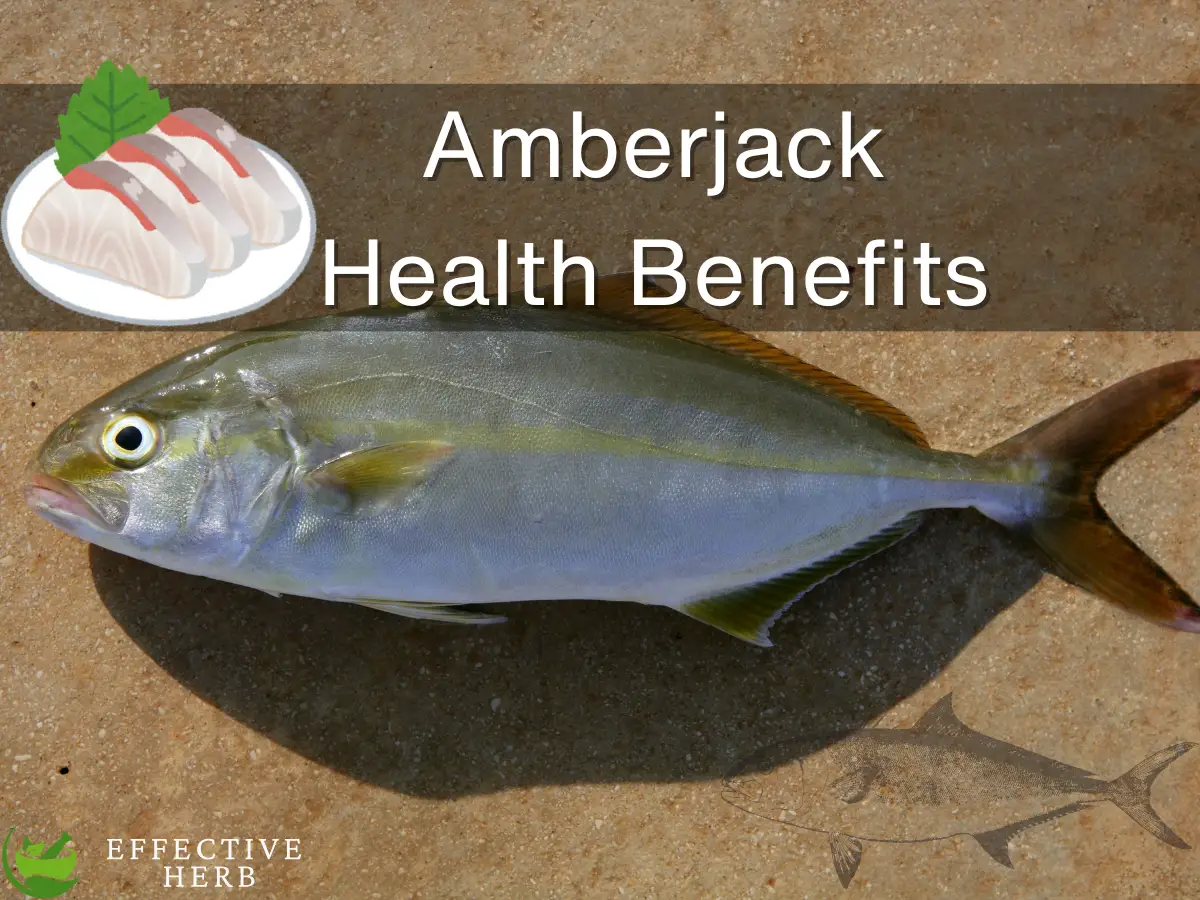Amberjack Health Benefits
Amberjack fish are super popular among people who love fishing and eating seafood. They’re part of the Carangidae family and like hanging out in warm waters all around the world. These fish have cool amber-colored stripes, and they’re huge. People love catching them because they’re a challenge, and they taste delicious, too. That’s why both folks who fish for fun and those who sell fish really like them.
Amberjacks are Atlantic and Pacificfish in the genus Seriola of the family Carangidae. They are widely consumed across the world in various cultures, most notably for Pacific amberjacks in Japanese cuisine; they are most often found in the warmer parts of the oceans.[1] There are many variations of amberjack, including greater amberjack (Atlantic), lesser amberjack (Atlantic), Almaco jack (Pacific), yellowtail (Pacific), and the banded rudderfish (Atlantic). Though most of the Seriola species are considered “amberjacks”, the species Seriola hippos (samson fish) is not.
en.wikipedia.org/wiki/Amberjack
Etymology of Amberjack
The name “amberjack” likely comes from an old French word, “amberjac.” It’s made up of two parts: “Ambra,” which means amber (like the color), and “Jacques,” a type of fish. So, the name might mean the fish looks a bit like amber and is part of the “jack” fish family. This information helps folks know what kind of fish it is!
Region-specific Amberjack Common Names
Amberjacks, the robust and formidable fish inhabit oceans across the globe, showing a fascinating range of sizes, colors, and behaviors specific to their regions. From the Atlantic’s deep blue expanses to the warmer waters of the Pacific, each amberjack species possesses distinct characteristics and habitats, earning them a multitude of names in different parts of the world, including:
- Australia: Samson fish
- Brazil: Olho de Boi
- Caribbean: Reef Donkey
- France: Seriole
- Greece: Goutsa
- India: Indian Amberjack or Kari / Paarai
- Indonesia: Ikan Kuniran
- Italy: Ricciola
- Japan: Hamachi or Yellowtail Amberjack
- Mexico: Medregal
- Mediterranean Region: Seriola or Seriola dumerili
- Mauritius: Yellowtail Kingfish
- Mozambique: Kingfish (along the southeastern coast of Africa)
- New Zealand: Kingfish
- Philippines: Talakitok or Balat
- South Africa: Yellowtail
- South Korea: Buri
- Spain: Jurel
- Taiwan: Huang Pian Yu
- United States: Greater Amberjack
Most of the countries listed are involved in the fishing of Amberjack. However, the extent of fishing activity can vary. Countries like Japan, the United States, Mexico, Australia, and several Mediterranean countries have notable fishing industries targeting Amberjack. Other countries might have limited commercial fishing operations for Amberjack but could still have local or smaller-scale fishing activities targeting this species for consumption or recreational purposes.
Distribution of Amberjack Fish
Amberjack fish are commonly found in various oceanic regions, including the Atlantic, Pacific, and Indian Oceans. They’re often spotted in areas like the Gulf of Mexico and the Caribbean Sea in the Atlantic. In the Pacific, they’re widespread, ranging from the coast of California to the western Pacific. They prefer warmer waters and can be found in offshore habitats near reefs or rocky areas.
Amberjack Taxonomy
The taxonomy of amberjack fish typically falls under the following classification:
- Kingdom: Animalia
- Phylum: Chordata
- Subphylum: Vertebrata
- Class: Actinopterygii (ray-finned fishes)
- Order: Perciformes (perch-like fishes)
- Family: Carangidae (jackfishes and trevallies)
- Genus: Seriola
In the group of fish called Seriola, you can find species like the greater Amberjack, also known as Seriola dumerili. Just remember, the names and groups of fish can change as scientists learn more.
Amberjack Morphological Features
It is necessary to know morphological features to choose the right breed to get Amberjack health benefits. It can be categorized into the following groups:
Body Shape and Size
Amberjacks typically have elongated, streamlined bodies with a sloping forehead and a pointed snout. Their sizes can vary, with some species reaching over 6 feet.
Coloration and Patterns
These fish usually have a dark bluish-green to olive-colored back, fading to a silvery-white belly. Some species display distinct horizontal stripes or bands along their bodies.
Fins and Tail
Their dorsal fins are divided into two sections – the first with strong spines and the second with softer rays. The anal fin is usually elongated. The caudal fin, or tail, is profoundly forked and aids in swift movement through the water.
Head and Mouth
The head of an Amberjack is relatively large in proportion to its body, with a robust jaw structure containing sharp teeth. Their mouths are usually giant, facilitating their carnivorous diet.
Scales and Skin
Their scales are relatively small, embedded in their skin, and have a smooth texture. The skin is resilient and coated in a mucus layer, aiding in streamlined movement through water.
Skeletal Structure
Amberjacks possess a robust skeletal framework, giving them the necessary support for their muscular structure. Their bones are well-developed and adapted for rapid movement and agility in the water.
Lateral Line
Like many other fish, Amberjacks have a lateral line system, a row of sensory organs running along each side of their body. These lateral lines help them detect changes in water pressure, assisting in navigation and finding prey.
Remember, the specific morphological features can vary among different species of Amberjack, but these general characteristics are common among them.
Amberjack Health Benefits
Amberjack’s health benefits are numerous, which have been listed here :
Rich in Omega-3 Fatty Acids
Amberjack is a good source of omega-3 fatty acids, which promote heart health and reduce inflammation.
High Protein Content
It provides substantial protein, essential for muscle repair, immune function, and overall body maintenance.
Vitamins and Minerals
Amberjack contains vitamins like B6, B12, and niacin and minerals such as selenium and phosphorus, contributing to various bodily functions.
Low in Saturated Fat
Being low in saturated fat makes Amberjack a heart-healthy protein option, as excessive saturated fat intake is linked to cardiovascular issues.
Boosts Cognitive Function
The omega-3 fatty acids in Amberjack are associated with improved cognitive function and may help reduce the risk of neurodegenerative diseases.
Supports Bone Health
Rich in phosphorus, Amberjack contributes to maintaining strong and healthy bones.
Weight Management
With its high protein content, Amberjack can aid in weight management by promoting a feeling of fullness and supporting lean muscle mass.
Heart Health
Omega-3 fatty acids in Amberjack can help lower blood pressure, reduce triglyceride levels, and enhance overall cardiovascular health.
Eye Health
The presence of omega-3s contributes to eye health, potentially reducing the risk of age-related macular degeneration (AMD) and promoting good vision.
Skin Health
Essential fatty acids support skin health by maintaining its elasticity and moisture, potentially reducing the signs of aging and promoting a healthy complexion.
Anti-Inflammatory Properties
Amberjack’s omega-3 content may aid in managing inflammatory conditions, such as arthritis, by reducing joint pain and stiffness.
Metabolism Boost
The protein content in Amberjack can boost metabolism, supporting weight loss or weight maintenance efforts.
Improved Mood
Omega-3 fatty acids are linked to mental well-being and may help alleviate symptoms of depression and anxiety, contributing to an improved mood.
Reduced Cancer Risk
Some studies suggest that regular consumption of fish rich in omega-3s, like Amberjack, may be associated with a reduced risk of certain cancers.
Immune System Support
Vitamins and minerals in Amberjack, including vitamin B6 and selenium, support a healthy immune system.
Muscle Health
The protein in Amberjack is crucial for muscle repair and maintenance, making it beneficial for athletes and those engaging in regular physical activity.
Regulated Blood Sugar
The omega-3 fatty acids may contribute to better insulin sensitivity, potentially assisting in managing blood sugar levels.
Anti-Aging Properties
Antioxidants in Amberjack, such as selenium, can help combat oxidative stress, potentially slowing down the aging process at a cellular level.
Aid in Wound Healing
Protein, vitamins, and minerals in Amberjack contribute to the body’s ability to heal wounds and regenerate tissues.
Thyroid Health
Selenium, found in Amberjack, is crucial in thyroid hormone metabolism, supporting overall thyroid health.
Improved Sleep Quality
Omega-3 fatty acids may improve sleep quality and benefit individuals with sleep disorders.
Reduced Risk of Stroke
Regular consumption of fish like Amberjack has been associated with a lower risk of stroke, possibly due to its positive impact on blood clotting and circulation.
Menstrual Health
The anti-inflammatory properties of omega-3 fatty acids may help alleviate menstrual cramps and discomfort in some women.
Liver Health
Some studies suggest that omega-3 fatty acids support liver health by reducing fat accumulation and inflammation.
Balanced Cholesterol Levels
Incorporating Amberjack into a heart-healthy diet may contribute to maintaining balanced cholesterol levels.
Improved Dental Health
The phosphorus content in Amberjack supports dental health by promoting tooth mineralization and bone density.
Enhanced Nutrient Absorption
Combining healthy fats and protein in Amberjack may enhance the absorption of fat-soluble vitamins like A, D, E, and K.
Remember, individual health needs can vary, so it’s essential to consider overall dietary patterns and consult with a healthcare professional for personalized advice to enjoy Amberjack’s health benefits.
Amberjack Bioactive Compound
A long list of bioactive compounds presented here illuminates the Amberjack’s health benefits, making it famous worldwide. So, go through it to familiarize yourself with them.
Proteins
Proteins comprise various amino acids like Histidine, Isoleucine, Leucine, Lysine, Methionine, Phenylalanine, Threonine, Tryptophan, and Valine. These amino acids play a crucial role in muscle development and repairing tissues. They’re essential for overall muscle health and help improve and grow body tissues.
Omega-3 Fatty Acids
Omega-3 fatty acids, specifically Eicosapentaenoic acid (EPA) and Docosahexaenoic acid (DHA) are known for their anti-inflammatory properties and benefits to heart health. They’re good for the heart and can reduce inflammation in the body.
Vitamins
Vitamin A
This vitamin, found in forms like Retinoic Acid, Retinol, and Retinal, is vital for vision, immune function, and maintaining healthy skin.
Vitamin B12
Present as Methylcobalamin, it supports nerve health and the production of red blood cells.
Vitamin C
Ascorbic Acid is an antioxidant, strengthens the immune system, and aids in collagen formation.
Vitamin D
Vitamin D3 (Cholecalciferol) is essential for bone health and supports the immune system.
Vitamin E
Alpha-tocopherol acts as an antioxidant, protecting cells from damage.
Vitamin K
Essential for blood clotting and bone metabolism.
Niacin (Vitamin B3)
It helps in energy production and maintains healthy skin.
Riboflavin (Vitamin B2)
Essential for energy production and cell growth.
Folate (Vitamin B9)
Essential for DNA synthesis and cell growth.
Minerals
Calcium
Essential for bone, teeth, muscle health, and nerve signaling.
Phosphorus
Vital for bone and teeth health and energy metabolism.
Magnesium
It is crucial for muscle, nerve function, and bone health.
Iron
Essential for oxygen transport and overall energy metabolism.
Zinc
Supports immune function, wound healing, and DNA synthesis.
Selenium
It acts as an antioxidant and is crucial for thyroid function.
Iodine
Essential for thyroid function and hormone production.
Copper
It is involved in red blood cell formation and supports connective tissue.
Manganese
Essential for bone formation, blood clotting, and reducing inflammation.
Potassium
Critical for maintaining fluid balance, nerve transmission, and muscle contractions.
Other Essential Nutrients
Choline
Vital for brain health and various metabolic processes.
Biotin
It supports metabolism and helps maintain healthy skin, hair, and nails.
Additional Compounds
Taurine
Supports cardiovascular function and eye health.
Carotenoids (Other than Astaxanthin)
Canthaxanthin and zeaxanthin, apart from vitamin A, may have antioxidant properties.
Phospholipids (Other than Omega-3 Fatty Acids)
It is found in fish oils, potentially influencing lipid metabolism.
Mycosporine-like Amino Acids(MAAs)
This compound has UV-absorbing properties and contributes to skin protection. It’s found in fish skin.
Coenzyme Q10 (Ubiquinone)
It plays a role in energy production and has antioxidant properties.
Lectins
Proteins with potential immune-modulating properties.
Nucleotides
They serve as building blocks for DNA and RNA and have potential roles in immune function.
Possibilities of Parasites in Amberjack
Amberjack fish, known for its robust flavor and firm texture, can occasionally harbor parasites or worms. Consumers should be aware of the existence of parasites in Amberjack to avoid any damage to health rather than to get Amberjack health benefits.
Types of Worms
Anisakid Nematodes
Common parasites found in marine fish, these worms may infest the flesh of Amberjack. They can cause health issues if consumed raw or undercooked.
Roundworms (Cestodes)
Another category of parasites that might be present is these flat, ribbon-like worms, which can be of concern when consuming inadequately cooked or raw Amberjack.
Potential Health Risks
Ingesting fish contaminated with these parasites may result in health issues, such as digestive discomfort, allergies, or even more severe complications. Employing adequate cooking techniques, like freezing or ensuring thorough cooking, can help reduce these potential risks.
Symptoms of Parasitic Infection
- Nausea and Vomiting: An initial sign of parasitic infection after consuming contaminated Amberjack.
- Abdominal Discomfort: Cramps or pain in the abdominal region may indicate a parasitic presence.
- Allergic Reactions: In some cases, allergic responses to parasites can manifest, necessitating immediate medical attention.
Prevention and Safety Measures
- Cooking: Thoroughly cook Amberjack to an internal temperature of at least 145°F (63°C) to kill potential parasites.
- Freezing: If raw or undercooked Amberjack is consumed, freezing it at -4°F (-20°C) for a minimum of seven days can deactivate parasites.
- Source Awareness: Purchase fish from reputable suppliers to minimize the risk of contamination.
Regulatory Standards
Health and food safety organizations globally set standards for acceptable parasite levels in fish. Following regulatory standards ensures the safe consumption of the Amberjack.
Parasites’ Identification and Handling
Amberjack, a fish many people like to catch, can have different parasites. Some common ones are copepods that stick on the outside, isopods that dig into their skin, and flatworms that might live in their stomachs. It’s essential for people fishing to regularly check the fish’s gills, fins, and body, making sure to avoid parasitic fish. Following the rules set by local authorities and fishing groups is a good idea to avoid getting infected by these parasites.
Summary: Parasites in Amberjack
While Amberjack is a delectable fish, awareness of potential parasites is crucial for safe consumption. By adopting proper cooking methods and sourcing fish responsibly, consumers can enjoy this delicacy while minimizing health risks.
Culinary Features of Amberjack Fish
- Flavor and Texture
- Taste: Amberjack boasts a mild, slightly sweet flavor profile.
- Texture: Its meaty, firm texture makes it adaptable to various cooking methods.
- Culinary Utilization
- Grilling: Often prepared grilled with a medley of herbs, spices, or citrus for enhanced flavors.
- Baking: Suitable for baking whole fish or filets, usually seasoned with a blend of herbs and served with sauces.
- Pan-Seared: Maintains its texture and taste, allowing for diverse seasoning options.
- Sushi and Sashimi: Sushi and sashimi are highly valued in Japanese cuisine due to their firmness and mild taste.
- Ceviche: It is a dish that is prepared by adding citrus juices. The Amberjack is well-fitted to prepare this dish.
- Culinary Usage Around the World
- Mediterranean Cuisine: Commonly integrated into Mediterranean dishes, often grilled or baked with local herbs and flavors.
- Caribbean Cuisine: Popularly enjoyed grilled, often paired with tropical fruits and sauces.
- Japanese Cuisine: In Japan, it’s esteemed for sushi and sashimi owing to its texture and subtle taste.
- Global Culinary Diversity: Due to its versatility, it is employed in diverse cuisines worldwide, from fish tacos to sophisticated seafood preparations.
- Cooking Recommendations
- Avoid Overcooking: Maintaining its juiciness is critical, so avoid overcooking Amberjack.
- Seasoning Flexibility: Its mild flavor welcomes a wide range of seasoning choices, from robust spices to delicate herbs and citrus.
Amberjack’s culinary adaptability makes it a beloved choice among chefs and seafood enthusiasts globally.
Fishes Comparable to Amberjack
Explore a collection of fish that share similarities with the popular Amberjack! These fishes boast similar textures and tastes, making them versatile for various cooking methods. From the buttery richness of yellowtail to the mild sweetness of mahi-mahi or the meatiness of swordfish and striped bass, there’s something to suit every flavor preference. Used in dishes from places like the Caribbean, Mediterranean, Southeast Asia, and the United States, these fish bring their unique flavors to different cuisines, much like the beloved Amberjack.
Albacore Tuna:
- Characteristics: Firm texture, mild flavor.
- Cuisine Regions: Japan, Mediterranean countries, United States.
Almaco Jack:
- Characteristics: Similar to Amberjack in taste and texture.
- Cuisine Regions: Caribbean, Bahamas, Greater Antilles.
Barracuda:
- Characteristics: Firm texture, intense flavor.
- Cuisine Regions: Caribbean, Jamaica, and other islands in the region.
Cobia:
- Characteristics: Firm texture, sweet, mild flavor.
- Cuisine Regions: Southeast Asia (Japan, Philippines), United States.
Mahi-mahi (Dorado or Dolphin fish):
- Characteristics: Firm texture, mildly sweet flavor.
- Cuisine Regions: Caribbean, Central and South America, Hawaii, Pacific Islands.
Striped Bass:
- Characteristics: Meaty texture, mild, sweet flavor.
- Cuisine Regions: United States, particularly along the Atlantic coast.
Swordfish:
- Characteristics: Meaty texture, mildly sweet taste.
- Cuisine Regions: Mediterranean, United States, Japan.
Tilefish:
- Characteristics: Firm texture, sweet, mild flavor.
- Cuisine Regions: United States, especially along the Atlantic coast.
Yellowtail:
- Characteristics: Firm texture, rich, buttery flavor.
- Cuisine Regions: Japan (sushi, sashimi), Korea, China, United States.
Bonito:
- Has a firm texture and a moderately strong flavor. It’s commonly used in Japanese cuisine for sashimi or dried and smoked for flavoring.
Kingfish:
- Like Amberjack in texture and taste, it’s often grilled or used in sashimi due to its firm flesh.
This list highlights the various fish, their key characteristics, and the regions where they are commonly utilized in culinary traditions.
Bottom Lines
Amberjack is a popular fish known for its great taste and being enjoyed in various places under different names. It’s packed with omega-3s, protein, and nutrients that are good for your heart, brain, and bones. Eating Amberjack can help with things like reducing inflammation and managing weight, but it’s important to think about what’s best for you when eating it.
Amberjack is packed with good stuff/ But, watch out for parasites. Cooking it well and buying from reliable sources is key for enjoying its yummy taste without risking your health. Just balance the benefits with being careful!
Amberjack fish is highly valued for its mild taste and versatility in dishes worldwide, from sushi in Japan to Mediterranean grilling. It’s popular in markets like Japan, the US Gulf/Southeast, and Mediterranean countries. However, there are worries about its sustainability and fluctuations in the market. Looking into industry reports can give more detailed information about these issues.







